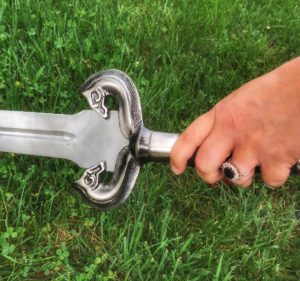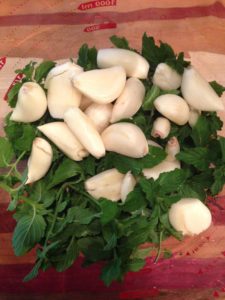
Not long ago, I was talking with a friend about the rude awakening I received the year I discovered that gardening wasn’t easy. How do I describe this? Imagine with me for a moment: Deep in the heart of the garden, a great battle rages against an evil so vile that it has set its sights upon the destruction of…. Your garden. I know. It sounds dramatic, almost like the introduction of an epic novel or film. I suppose, in some ways it is. You see, the garden faces many obstacles. Problems can occur within the soil, the plant, nature’s elements and even the gardener’s abilities, or lack thereof. It wasn’t until that second year of gardening, when I came to realize that success is not guaranteed. In gardening, there is no easy button. It requires an undaunted persistence and a willingness to fight. For me, it all started with bugs.
In my second year, I had decided to try growing potatoes. Potatoes love loose and sandy soil. It provides the movement needed for the underground stems (tubers) to grow. In most cases, potatoes do better in northern regions because they are a cool season crop. If I haven’t said this already, Canada grows the best potatoes. I kid you not – the flavor and taste are the best. They don’t require adding huge amounts of milk, butter, or spices. They’re great on their own. If you ever find potatoes “grown in Canada,” don’t hesitate; just buy them! Needless to say, I was pretty confident that my potatoes would taste great simply because I was Canadian (cue audience laughter).
By the time my potato plants were beginning to flower, I had noticed that one or two of them were starting to wilt. I assumed they needed water so I pulled out the hose. When they didn’t perk up from watering, I took a closer look and found some holes in the leaves. “That’s strange,” I thought. A few days later, things were getting worse. At that point, I saw an orange bug with black stripes sitting on the leaves. I took a picture of it and called my Gardening-Jedi. Brenda said without hesitation, “you’ve Potato Beetles. Oh yeah, they’re bad this year.” There’s something reassuring about hearing her say, “Don’t worry, I’ve got them too. Just head up to Southern States and get some spray.” A word of caution. If you’ve never tried to find a “spray” at a farm/gardening center, it’s easy to become overwhelmed with the number of options. There are lots of chemical treatments out there. For me, I do my best to stick with organic treatments. Back when I started, I wasn’t familiar with the marriage between organic prevention and organic treatment. For those wanting to pursue organic gardening, you need to practice prevention techniques such as crop rotation and the incorporation of plants that attract “good bugs” to help minimize your soil born issues and reduce your bad bug infestations. But even with the best prevention, organic treatments may be required. These treatments will not be “instant” like chemical treatments. They tend to take time and usually frequent applications. Several are designed to interrupt the breeding and growing process of new bugs. After I purchased my organic “Colorado Potato Beetle” treatment, I followed the instructions over the next few weeks and my persistence paid off. I had conquered them!
I wish I could tell you that this was my only bug problem that year. The following month, I was introduced to a new menace; the cucumber beetle. I’m going to be completely honest with you. When I first saw this bug, I thought it was a yellow ladybug. It wasn’t until my cucumber plants were under siege that I went to the internet for help. Unlike ladybugs, cucumber beetles wreak havoc by eating holes in the leaves of the plants while unleashing their young at the root. Over time, the leaves wilt and turn yellow. In my garden, these beetles couldn’t seem to hold back from attacking my squash plants as well. I still remember the day I ventured out to the garden only to find the beetles had decided to host a family reunion on my zucchini. Anger welled up within me as I screamed: “What is wrong with you?! This is a zucchini plant! You are CUCUMBER beetles!” I can only imagine what my mail lady would have thought if she had arrived at that moment.
This is the same year that these crazed beetles worked in tandem with vine borer. I had been treating the cucumber beetle but my plants were still suffering. At that point, I called for reinforcement. Brenda came over and took a look at the zucchini plants. Immediately she said: “Well, you took are of the beetles but now you’ve got vine borer.” Great. Something new to fight. I discovered that vine borer larva will burrow themselves into the base of the plant, eating it from the inside out. The leaves will wilt and die as the larva eat and move from one part of the plant to another. By the time we found them, the larva were already feasting on several plants. I was desperate to try to save them. Can you believe I actually watched a video of a guy teaching people how to surgically remove vine borer larva from a zucchini plant? I took this hippy’s advice and conducted my first extraction. I’m pretty sure my surgical skills would earn me a medical residency at our local university hospital.
 By the end of that summer, I was overwhelmed. I remember thinking, “Why on earth am I still doing this?” Looking back, that season is comically referred to it as the “Year of the Pest.” I did end up finding treatments that worked but not before I tried every natural and organic “mom and pop” online treatment. One of them had me brew garlic, mint and cayenne pepper with instructions to spray my plants three times a day. I’ll save you the trouble; it didn’t work and my basil didn’t smell like basil anymore. I remember joking with Brenda, “Will I ever get the hang of this?” She laughed and told me, “Girl, I’m still learning. Thank God for google!”
By the end of that summer, I was overwhelmed. I remember thinking, “Why on earth am I still doing this?” Looking back, that season is comically referred to it as the “Year of the Pest.” I did end up finding treatments that worked but not before I tried every natural and organic “mom and pop” online treatment. One of them had me brew garlic, mint and cayenne pepper with instructions to spray my plants three times a day. I’ll save you the trouble; it didn’t work and my basil didn’t smell like basil anymore. I remember joking with Brenda, “Will I ever get the hang of this?” She laughed and told me, “Girl, I’m still learning. Thank God for google!”
So what is my point in telling you this? Is it to scare you away from gardening? No. Here’s the plain and simple truth; gardening requires effort! I said it earlier and I’ll say it again – there is no easy button. Gardeners have to have battle strategies as they cultivate their gardens in order to pursue a harvest.
Those of you who know me personally know where I’m going with this. God used my “Year of the Pest” to speak to me about the spiritual battle we all face. There is a battle for the heart in an epic story God masterfully tells throughout His creation. There is an enemy whose sole purpose is destruction. And there is a hero sent to redeem the hearts of men and women. For those of us who have chosen to follow Christ, we must understand that the battle still rages even after salvation. Scripture is clear that our journey with God will not be easy. In John 16:33, Jesus speaks to his disciples and says, “I have told you all this so that you may have peace in me. Here on earth you will have many trials and sorrows. But take heart, because I have overcome the world.” Christ did not promise a life without hardship but He did promise that He would be with us. He would never leave us. Our journey requires us to fight for our hearts. When we face hardship and opposition, we need to press into God with persistence and ask Him for strategy. He knows exactly what is happening. God also brings people into our lives who will fight alongside us. These allies are the ones that aren’t afraid to walk into our garden and help us see what’s going on without judgement. Beware of those who use clichés like, “God won’t give you more than you can handle,” or “When God closes a door, He’ll open a window,” or better yet, “You just need to have more faith.” These haphazard comments aren’t helpful in the face of battle wounds, sorrow, and suffering. In fact, they can do more harm than good. It communicates a “get over it” message with generic solutions while never recognizing the person’s heart or story. It would be like me assuming that I needed to water every time I see yellow and wilted leaves. The reality is, there are many causes for yellowing and wilting. Imagine what would have happened if I chose to continue watering daily because I wasn’t seeing the plants perk up. Eventually, I would kill them… with water!
I’ll leave you with this, by the end of that summer I learned a few things. I learned that it is important to take a closer look before assuming I understand the problem and apply treatment. I learned that it is crucial to walk in humility and ask for help when needed. And most of all, I’ve learned that making mistakes does not mean I’ve done irreparable damage to the garden or harvest. The truth is, we learn from by making mistakes. The key is to never give up!
This is so good! Remembering there is no easy button. I love that you called an experienced gardener, who said she is STILL learning. Isn’t that it? None of us are exempt from the battle. I love the work you put into your garden, and these blogs. They touch my heart.
It was so crazy talking to you this morning after I had already written this! I totally agree with you – no matter how “old” we are in God, we’re still learning 🙂
I’ve had a year (or more) of “The Pests”. Love how God gives the real life metaphor through your blog…I’ve been accepted to med-surge & find my bigger problems are wanting to perform surgery on my husband. Lol.
Loving this.
I know you have! Kathryn, I pray for you often. I don’t care whether you were a baby Christian or a mother in the faith… We all face an enemy who’s sole purpose is to take us out. There is something so redemptive and beautiful about knowing we are not alone.